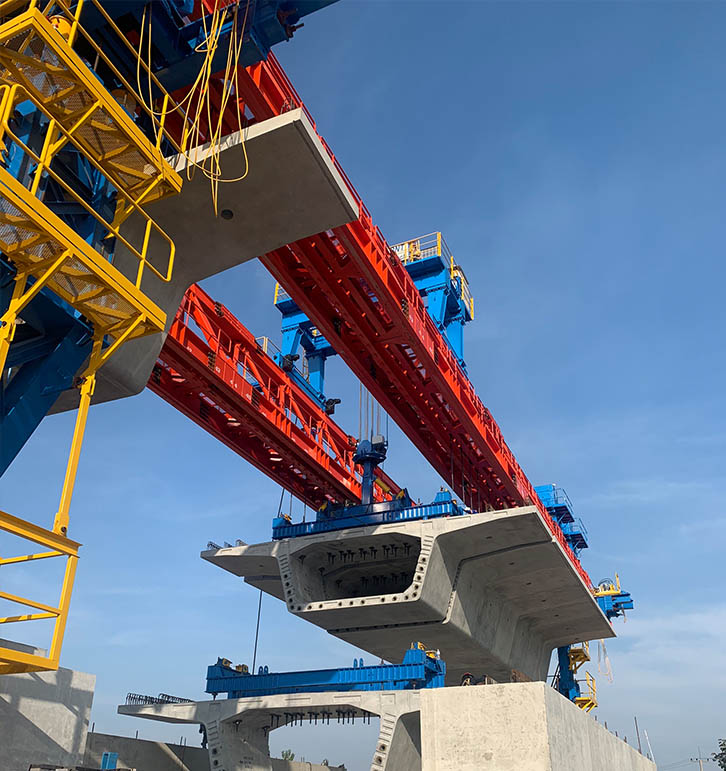Essential Safety Guidelines for Operating Construction Cranes
Date: 2024-07-18 Share:
Importance of Adhering to Safety Protocols
Understanding the Risks Involved
Operating construction cranes is a complex task intertwined with numerous risks. These massive machines are vital in lifting heavy loads, but improper handling can lead to devastating consequences including property damage, injuries, or even fatalities. Understanding the inherent risks involved, such as crane tip-overs, falling loads, and operator error, is the first step toward maintaining a safe and efficient working environment. Knowledge of these potential hazards ensures that all team members take the necessary precautions seriously.

Legal and Regulatory Responsibilities
Compliance with OSHA Standards
Compliance with Occupational Safety and Health Administration (OSHA) standards is crucial for any construction site. OSHA provides comprehensive guidelines to ensure the safe operation of construction cranes, incorporating rules on equipment maintenance, operator training, and site safety. These standards are not just recommendations but legal obligations, designed to protect workers’ health and safety. Adhering to OSHA regulations helps minimize accidents and enhances overall workplace safety.
Local and National Regulations
Apart from OSHA, various local and national regulations must be observed. These laws can vary significantly depending on the location, adding another layer of safety protocol that construction companies must navigate. From permits to specific crane operation limits, local regulations ensure that all activities fall within a legal framework that prioritizes public and worker safety. Regularly reviewing and understanding these regulations is necessary for maintaining compliance and avoiding potential fines or legal issues.
Pre-Operation Safety Measures
Site Inspection and Preparation
Identifying Potential Hazards
Prior to operation, a thorough site inspection is essential. Identifying potential hazards such as overhead power lines, unstable ground, and restricted areas can significantly reduce the risk of accidents. A meticulous examination helps in planning the crane operation effectively, ensuring that all risk factors are addressed beforehand. Regular hazard assessments should be a routine part of job site safety checks to mitigate any unforeseen dangers.
Ensuring Stability of Ground Conditions
The stability of ground conditions is critical for safe crane operations. Unstable ground can lead to crane tipping, posing severe risks to operators and workers. Conducting soil tests and ensuring proper ground compaction can help in identifying and resolving issues related to ground stability. Stabilizing the crane base with appropriate matting and supports also plays a significant role in maintaining a safe lifting environment.
Equipment Inspection and Maintenance
Regular Inspection Checklists
Utilizing regular inspection checklists is a fundamental aspect of crane safety. These checklists cover all critical components of the crane, from structural integrity to mechanical parts. Operators and maintenance personnel should meticulously inspect the crane before each shift to ensure all elements are in optimal working condition. Identifying and addressing issues through these checklists can prevent equipment failure and enhance operational safety.
Importance of Timely Maintenance
Timely maintenance of construction cranes is not negotiable; it’s essential for prolonging machinery life and ensuring safe operation. Scheduled preventive maintenance should be carried out by qualified technicians to address wear and tear before it leads to serious malfunctions. Keeping detailed records of maintenance activities aids in tracking the crane’s history and anticipating future servicing needs, thereby safeguarding against potential breakdowns during critical operations.
As one of the famous brands in the production of winches, cranes and crane parts, Nante Crane is dedicated to research and development of lifting and material handling technologies. We adopt innovative ideas and design in developing new products and services. Backed up by a wealth of industrial experience, we can provide customers with high quality lifting equipment and components.
Operator Training and Certification
Training Requirements for Crane Operators
Accredited Training Programs
Crane operators must undergo accredited training programs that cover both theoretical knowledge and practical skills. These programs ensure that operators are well-versed in the safe handling, operation, and emergency procedures related to construction cranes. Accredited programs often include modules on load management, understanding crane dynamics, and accident prevention techniques, equipping operators with the requisite expertise to perform their duties safely.
Continual Professional Development (CPD)
Continual Professional Development (CPD) is another critical aspect of operator training. The construction industry is continually evolving, and staying updated with the latest safety protocols, technological advancements, and operational best practices is essential. Regularly attending workshops, participating in training courses, and staying informed about industry trends can enhance an operator’s skill set and knowledge base, ensuring high safety standards.
Certification and Licensing
Certification Processes
Obtaining certification from recognized bodies is a mandatory requirement for crane operators. The certification process typically involves passing written examinations and practical assessments that test the operator’s ability to handle various crane models and scenarios safely. Certification validates the operator’s competence, providing an added layer of assurance regarding their capability to manage construction cranes responsibly.
Importance of Valid Licenses
Maintaining valid licenses is vital for legal and safety reasons. Operators with expired or invalid licenses pose significant risks not only to themselves but also to their colleagues and overall project integrity. Regularly updating licenses, in accordance with industry regulations and legislative requirements, ensures that operators remain authorized and fit to handle construction cranes, thereby playing a crucial role in operational safety.
By incorporating these detailed safety measures, construction sites can significantly reduce the risks associated with crane operations and ensure a safer working environment for everyone involved.
Daily Operational Protocols
Conducting Pre-Shift Meetings
Daily operational safety starts with conducting pre-shift meetings. These briefings are crucial for communicating the tasks, responsibilities, and potential hazards for the day. During these meetings, supervisors can outline specific job assignments and ensure that all crew members understand the safety protocols in place. This approach not only fosters a collaborative atmosphere but also reinforces the importance of adhering to safety guidelines, which is essential for the seamless operation of construction cranes.
Briefing on Tasks and Hazards
Briefing on tasks and potential hazards is a fundamental component of pre-shift meetings. Highlighting areas of concern—such as heavy lifts, close proximity to other heavy machinery, or operations near high-voltage power lines—can preempt accidents. Clear communication about the day’s objectives and associated risks makes it easier for team members to stay vigilant. Effective hazard communication also ensures that workers are better prepared to react correctly in the face of unforeseen circumstances, thereby minimizing risks.
Assigning Responsibilities
Assigning responsibilities during pre-shift meetings ensures clarity and accountability among crew members. Explicitly designating roles helps in preventing confusion, especially during critical crane operations. Each team member should know their specific duties, whether it’s rigging, signaling, or monitoring loads. This organized approach optimizes workflow and enhances overall safety, as everyone knows what is expected of them and can focus on performing their tasks effectively.
Safe Load Management
Safe load management is one of the cornerstones of crane operation safety. Proper handling and lifting techniques are vital to prevent accidents that may arise from exceeding load capacities or improper rigging. Operators and crew members must be thoroughly versed in load management protocols to ensure that all lifting activities are carried out within the crane’s operational limits.
Determining Load Capacities
Determining load capacities accurately is essential to avoiding overloading, which is a frequent cause of crane accidents. Operators should always consult the crane’s load charts, ensuring that the weight of the load, including any lifting accessories, does not exceed the manufacturer’s specifications. By adhering to these limits, operators can prevent structural failures and ensure the crane maintains its stability throughout the lifting process.
Safe Lifting Techniques
Employing safe lifting techniques is crucial for minimizing risks during crane operations. This includes using appropriate rigging methods, ensuring the load is balanced, and lifting it slowly to avoid sudden movements that could destabilize the crane. Continuous communication between the operator and ground personnel through hand signals or radio ensures coordinated movements, further enhancing safety during lifts. Employing such conscientious techniques can greatly reduce the likelihood of accidents and injuries.
Emergency Procedures and Response Plans
Establishing Emergency Protocols
Establishing clear emergency protocols is indispensable for mitigating the impact of unexpected incidents on construction sites. These protocols should encompass all potential emergencies, including mechanical failures, crane collapses, and environmental hazards. Clearly defined procedures ensure that all workers know exactly how to respond in emergencies, thereby reducing panic and improving response times.
Identifying Potential Emergencies
Identifying potential emergencies in advance can significantly streamline the implementation of emergency response plans. Common emergency scenarios should be outlined, including steps to manage immediate risks, such as evacuating the area or shutting down crane operations. This proactive approach ensures that everyone on site is aware of their role and the actions they must take to ensure their safety and the safety of their colleagues.
Evacuation Plans
Evacuation plans are a critical aspect of emergency protocols. These plans should designate specific evacuation routes and assembly points, ensuring that all personnel can quickly and safely exit the area in case of an emergency. Regular evacuation drills improve familiarity with these routes and procedures, ensuring that everyone can evacuate efficiently without unnecessary confusion or delay.
First Aid and Medical Responders
Immediate medical attention can significantly mitigate the severity of injuries sustained in construction crane accidents. Ensuring prompt availability of first aid and trained medical responders on site is crucial for enhancing workplace safety.
Availability of First Aid Kits
First aid kits should be strategically placed throughout the construction site, easily accessible to all workers. These kits should be well-stocked with essential medical supplies, including bandages, antiseptics, and emergency contact information. Regular inventory checks ensure that the kits are adequately supplied at all times, allowing for prompt medical response to minor injuries or stabilizing more severe conditions until professional medical help arrives.
Trained First Responders
Having trained first responders on the construction site enhances the ability to manage medical emergencies effectively. These individuals should be well-versed in basic first aid, CPR, and the use of automated external defibrillators (AEDs). Their presence ensures that immediate and appropriate medical care is administered during critical moments, which can be lifesaving and reduce the risk of long-term injury.
As one of the famous winch production and manufacturing brands, Nante Crane is committed to helping our clients reduce investment cost, improve production efficiency, and economize energy consumption. Nante Crane’s main products include industrial cranes, offshore cranes, Launching Crane, electric hoists, crane travel unit, mobile power supply system etc. with reliable and excellent performance.
Implementing Technological Solutions for Enhanced Safety
Use of Crane Safety Devices
Technological advancements have introduced numerous safety devices that significantly enhance crane operation safety. Utilizing these devices can provide additional layers of protection against accidents and equipment failures.
Load Moment Indicators (LMI)
Load Moment Indicators (LMIs) are essential devices that measure the load being lifted and compare it with the crane’s capacity. By providing real-time data, LMIs alert operators when they are nearing the crane’s operational limits, preventing overloading and potential tip-overs. This technology ensures that operators can make informed decisions during lifts, significantly reducing the risk of catastrophic failures.
Anti-Two Block Devices (ATB)
Anti-Two Block (ATB) devices prevent the crane’s hook block from coming into contact with the boom tip, which can cause damage and lead to accidents. By preventing this “two-blocking” situation, ATB devices protect both the equipment and the operators, enhancing overall operational safety. These devices are particularly critical when lifting loads to significant heights, where the risk of two-blocking is higher.
Remote Monitoring Systems
Remote monitoring systems leverage technology to provide real-time insights into crane operations, enhancing safety and operational efficiency. These systems allow for constant oversight, ensuring that any anomalies are detected and addressed promptly.
Benefits of Real-Time Monitoring
Real-time monitoring systems offer significant safety benefits by continuously tracking crane performance and environmental conditions. Any abnormalities—such as excessive wind speeds or equipment malfunctions—can be immediately identified and addressed. This proactive approach allows operators to take preventative action before issues escalate into serious problems, ensuring a safer working environment.
Integration with Safety Protocols
Integrating remote monitoring systems with existing safety protocols creates a cohesive safety management approach. These systems can automatically log data, generate safety reports, and alert relevant personnel of any issues, facilitating swift responses to potential hazards. This integration enhances the effectiveness of safety protocols, ensuring that technological insights are utilized to maintain the highest standards of crane operation safety.
By adhering to these comprehensive safety guidelines, construction sites can significantly reduce the risks associated with operating construction cranes, ensuring the safety and well-being of all workers involved.
In addition to producing and manufacturing winches, Nante Crane has achieved breakthroughs in core technology and has the ability to manufacture core components, which are widely used in more than 20 professional fields such as advanced manufacturing, metal processing, aerospace, etc. Nante Crane is committed to the research and development and manufacturing of handling machinery and technology.
 English
English






